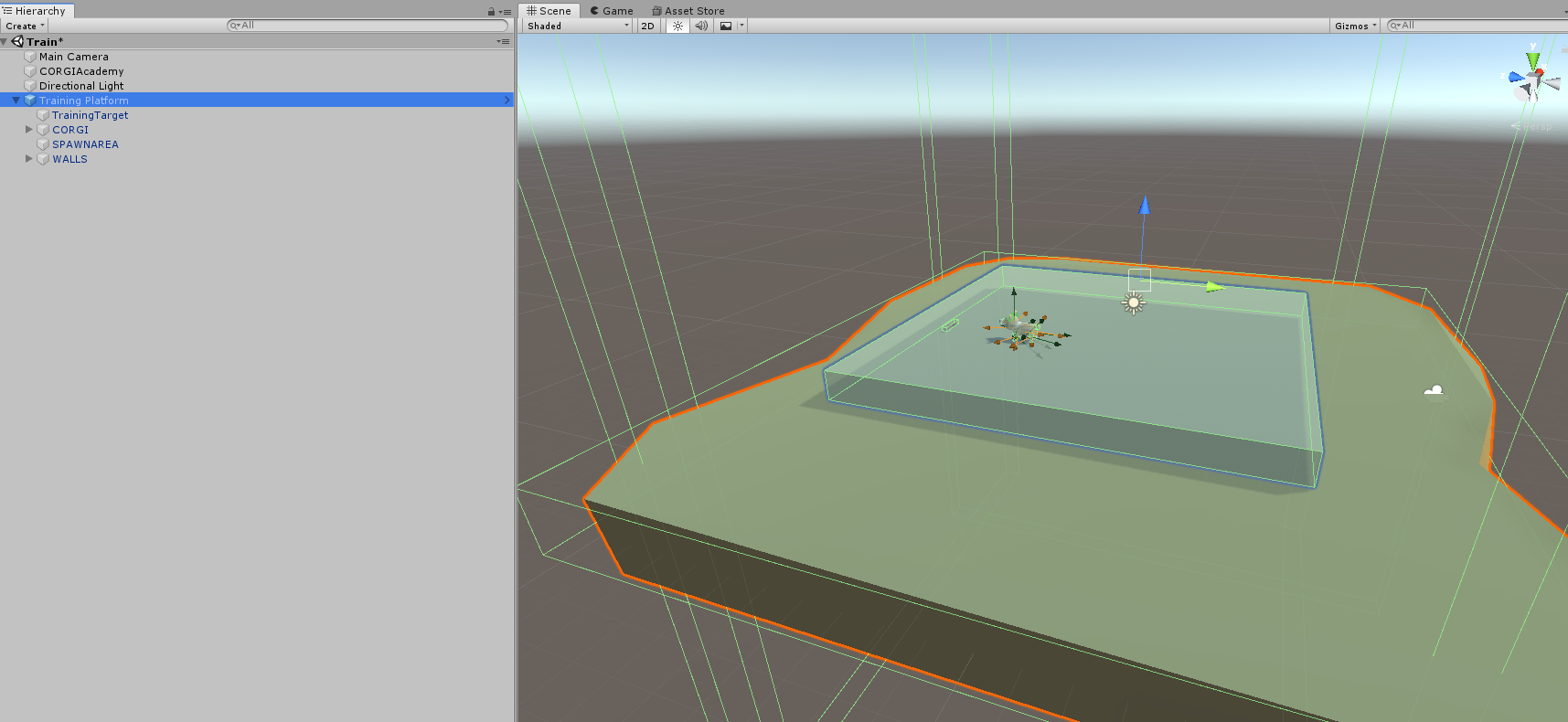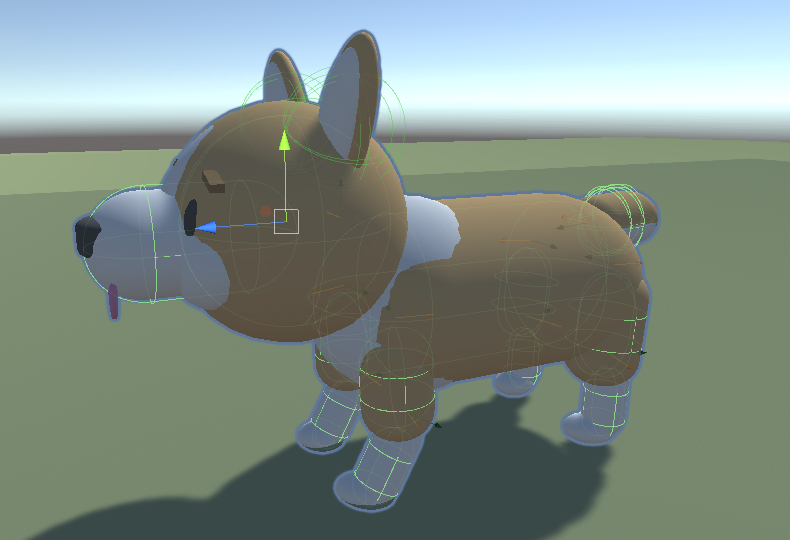퍼포 더 코기 : Unity ML-에이전트 툴킷으로 탄생한 재롱둥이 – Unity Blog
게임 제작은 게임 컨셉 및 로직 정의, 에셋 및 애니메이션 제작, NPC 동작 지정, 난이도 및 밸런스 조정, 출시 전 실제 플레이어를 통한 게임 테스트 등 여러 까다로운 작업이 수반되는 창조적 과정입니다. 유니티는 이러한 전체 제작 과정에서 머신러닝을 활용하는 것이 가능하다고...
blogs.unity3d.com
유니티 블로그에 ML-Agents 예제로 올라온 퍼포 더 코기에 대해서 정리를 해봤다.
코기가 타깃인 나무막대를 물어오는 예제인데 재미있는 점은 코기가 움직이는 방식
걷기, 달리기 점프, 물어오기와 같은 행동까지 학습을 했다는 점이었다.
유니티 블로그에서 퍼포 더 코기 유니티 프로젝트를 다운로드하고
기존 유니티 ML-Agents SDK를 다운로드한 곳에서 새로 프로젝트를 만들었다.

유니티 블로그에 자세하게 나타나 있는 것처럼 코기는 레그돌과 조인트 모터로 구성되어 있다.

아래는 코기의 학습을 수행하기 위한 Agent 코드이다.
using System.Collections;
using System.Collections.Generic;
using MLAgents;
using UnityEngine;
public class DogAgent : Agent
{
[HideInInspector]
// 코기가 다가가는 타겟
public Transform target;
// These items should be set in the inspector
[Header("Body Parts")]
public Transform mouthPosition;
public Transform body;
public Transform leg0_upper;
public Transform leg1_upper;
public Transform leg2_upper;
public Transform leg3_upper;
public Transform leg0_lower;
public Transform leg1_lower;
public Transform leg2_lower;
public Transform leg3_lower;
[Header("Body Rotation")]
public float maxTurnSpeed;
public ForceMode turningForceMode;
JointDriveController jdController;
[HideInInspector]
public Vector3 dirToTarget;
float rotateBodyActionValue;
// Counts the number of steps until the next agent's decision will be made
int decisionCounter;
// [HideInInspector]
public bool runningToItem;
// [HideInInspector]
public bool returningItem;
private void Awake()
{
//Joint Drive Setup
jdController = GetComponent<JointDriveController>();
jdController.SetupBodyPart(body);
jdController.SetupBodyPart(leg0_upper);
jdController.SetupBodyPart(leg0_lower);
jdController.SetupBodyPart(leg1_upper);
jdController.SetupBodyPart(leg1_lower);
jdController.SetupBodyPart(leg2_upper);
jdController.SetupBodyPart(leg2_lower);
jdController.SetupBodyPart(leg3_upper);
jdController.SetupBodyPart(leg3_lower);
}
void RotateBody(float act)
{
float speed = Mathf.Lerp(0, maxTurnSpeed, Mathf.Clamp(act, 0, 1));
Vector3 rotDir = dirToTarget;
rotDir.y = 0;
jdController.bodyPartsDict[body].rb.AddForceAtPosition(
rotDir.normalized * speed * Time.deltaTime, body.forward, turningForceMode);
jdController.bodyPartsDict[body].rb.AddForceAtPosition(
-rotDir.normalized * speed * Time.deltaTime, -body.forward, turningForceMode);
}
public void CollectObservationBodyPart(BodyPart bp)
{
var rb = bp.rb;
AddVectorObs(bp.groundContact.touchingGround ? 1 : 0);
if (bp.rb.transform != body)
{
AddVectorObs(bp.currentXNormalizedRot);
AddVectorObs(bp.currentYNormalizedRot);
AddVectorObs(bp.currentZNormalizedRot);
AddVectorObs(bp.currentStrength / jdController.maxJointForceLimit);
}
}
public override void CollectObservations()
{
AddVectorObs(dirToTarget.normalized);
AddVectorObs(body.localPosition);
AddVectorObs(jdController.bodyPartsDict[body].rb.velocity); // 몸통의 속도
AddVectorObs(jdController.bodyPartsDict[body].rb.angularVelocity); // 회전 속도
AddVectorObs(body.forward); // 몸통의 정면 방향 벡터
AddVectorObs(body.up); // 몸통의 윗 부분 방향 벡터
foreach (var bodyPart in jdController.bodyPartsDict.Values)
{
CollectObservationBodyPart(bodyPart);
}
}
public override void AgentAction(float[] vectorAction, string textAction)
{
var bpDict = jdController.bodyPartsDict;
// Update joint drive target rotation
bpDict[leg0_upper].SetJointTargetRotation(vectorAction[0], vectorAction[1], 0);
bpDict[leg1_upper].SetJointTargetRotation(vectorAction[2], vectorAction[3], 0);
bpDict[leg2_upper].SetJointTargetRotation(vectorAction[4], vectorAction[5], 0);
bpDict[leg3_upper].SetJointTargetRotation(vectorAction[6], vectorAction[7], 0);
bpDict[leg0_lower].SetJointTargetRotation(vectorAction[8], 0, 0);
bpDict[leg1_lower].SetJointTargetRotation(vectorAction[9], 0, 0);
bpDict[leg2_lower].SetJointTargetRotation(vectorAction[10], 0, 0);
bpDict[leg3_lower].SetJointTargetRotation(vectorAction[11], 0, 0);
// Update joint drive strength
bpDict[leg0_upper].SetJointStrength(vectorAction[12]);
bpDict[leg1_upper].SetJointStrength(vectorAction[13]);
bpDict[leg2_upper].SetJointStrength(vectorAction[14]);
bpDict[leg3_upper].SetJointStrength(vectorAction[15]);
bpDict[leg0_lower].SetJointStrength(vectorAction[16]);
bpDict[leg1_lower].SetJointStrength(vectorAction[17]);
bpDict[leg2_lower].SetJointStrength(vectorAction[18]);
bpDict[leg3_lower].SetJointStrength(vectorAction[19]);
rotateBodyActionValue = vectorAction[20];
}
void RewardFunctionMovingTowards()
{
float movingTowardsDot = Vector3.Dot(
jdController.bodyPartsDict[body].rb.velocity, dirToTarget.normalized);
AddReward(0.01f * movingTowardsDot);
}
void RewardFunctionTimePenalty()
{
AddReward(-0.001f); //-0.001f chosen by experimentation.
}
public void UpdateDirToTarget ()
{
dirToTarget = target.position - jdController.bodyPartsDict[body].rb.position;
}
private void FixedUpdate()
{
UpdateDirToTarget();
if (decisionCounter == 0)
{
decisionCounter = 3;
RequestDecision();
}
else
{
decisionCounter--;
}
RotateBody(rotateBodyActionValue);
var bodyRotationPenalty = -0.001f * rotateBodyActionValue;
AddReward(bodyRotationPenalty);
RewardFunctionMovingTowards();
RewardFunctionTimePenalty();
}
}
에이전트에서 수행하는 동작은 다음과 같다.
1.
코기의 다리 부분의 조인트 모터에 값 전달
(코기가 직접 달리거나 뛸 수 있도록 한다.)
2.
코기의 몸의 방향 설정
(목표로 하는 막대기로 향하도록 하고, 몸이 뒤집힌 경우 다시 일어나서 움직일 수 있도록 한다.)
3.
그 외에도 목표물을 향해 빠르게 다가가는 경우 보상,
시간이 지나는 경우 페널티 부과
using System.Collections;
using System.Collections.Generic;
using UnityEngine;
public class TrainingTarget : MonoBehaviour
{
[Header("General")]
public DogAgent trainee;
public Transform spawnArea;
private Bounds spawnAreaBounds;
// Use this for initialization
void Start()
{
spawnAreaBounds = spawnArea.GetComponent<Collider>().bounds;
SpawnItemTraining();
}
// Update is called once per frame
void FixedUpdate()
{
if (trainee.dirToTarget.magnitude < 1)
{
TouchedTargetTraining();
}
}
/// <summary>
/// Use the ground's bounds to pick a random spawn position.
/// </summary>
public void SpawnItemTraining()
{
Vector3 randomSpawnPos = Vector3.zero;
float randomPosX = Random.Range(-spawnAreaBounds.extents.x, spawnAreaBounds.extents.x);
float randomPosZ = Random.Range(-spawnAreaBounds.extents.z, spawnAreaBounds.extents.z);
transform.position = spawnArea.transform.position + new Vector3(randomPosX, 1f, randomPosZ);
}
/// <summary>
/// Agent touched the target
/// </summary>
public void TouchedTargetTraining()
{
trainee.AddReward(1); //Dog Fetch
SpawnItemTraining();
trainee.Done();
}
}
코기의 에이전트와 상호작용 하는 타깃은 위와 같이 동작한다.
1.
코기가 가까이 다가오는 경우 코기의 에이전트에 리워드 지급
랜덤 한 위치에 타깃 재 생성

유니티 블로그에서 제공하고 있는 코기 샘플만큼은 아니지만
의도대로 동작하는 모습을 확인했다.
코기 샘플을 이용하여 다음에는 응용한 다른 프로젝트를 진행해보려고 한다.
코기와 같은 방식으로 움직이는 인간형 모델을 생각해보면
아마 좀비? 가 가장 가깝지 않을까 생각이 든다.
'Unity' 카테고리의 다른 글
| [Unity] ml-agents 설치하기 및 테스트 (0) | 2020.01.19 |
|---|---|
| [Unity] ML-Agents로 간단한 강화학습 예제 만들어보기 (2) | 2019.05.16 |

